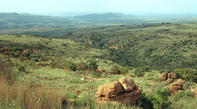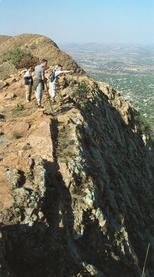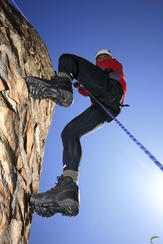Fauna and Flora

The Magaliesberg range of mountains, which forms a narrow wildlife sanctuary between the cities of Pretoria, Rustenburg, Johannesburg and Krugersdorp, is a special and unique natural feature, although it can easily be overlooked as nothing more than a line of unimpressive hills. Its main attraction is that it is a small piece of African bush amid the subcontinent's largest and fastest-developing urban and industrial complex. Deeply incised into its quartzitic scarps is a system of extensive gorges, with vertical sides reaching heights of up to 100 metres.
The Magaliesburg has a diverse range of fauna and flora. A mixed Afro-montane, bushveld and riverine forest vegetation finds refuge here: large tree ferns thrive in the spray of the waterfalls that fill the kloofs with their music. Wild fig trees send out showers of roots across the rock faces, spanning overhangs like the strings of huge harps. Occasionally a flush of forest birds flits through the dappled canopies, while black eagles and Cape vultures (which nest on the cliff faces) and martial eagles soar high in the sky at the very limit of human vision. Klipspringers and grey rhebuck are common in the rocky outcrops and open grasslands of summit grasslands, while brown hyaena, leopard and even the extremely rare pangolin or scaly anteater have been sighted here from time to time.
Fault Lines Formed the Kloofs

The Magaliesberg range's ecological significance is that it forms a link as well as a barrier between the temperate highveld grasslands to the south, and the northern bushveld savanna. Species from these two biomes co-exist here and form a unique mix. The kloofs which invest the mountains with such unexpected diversity and fertility cut the tilted, metamorphosed rocks at intersecting angles of 60 and 120 degrees - the very same angles that determine the crystalline structure of quartzite, from which the mountains are composed. The fault lines which form these kloofs must be fractures that formed when the weight of the Bushveld Igneous Complex thrust up the surrounding rocks.
The Best Loved is Tonquani

The low-lying Magaliesburg is actually an amazing place, for those who know it. The range is comprised of very hard quartzitic sandstone and is dissected by a series of vertical-sided kloofs that intersect at 70 and 120 degrees - the very same angles as the planes of quartz crystals. Each kloof has a stream that tumbles and frolics as it bounds over boulders and falls, plunging into pools and creating a miniature forested wonderland, such as at Grootkloof, Cederberg, Dome, Likkewaan, Trident and Mhlabathini. Perhaps the best loved is Tonquani, where hikers and rock climbers have camping for many a decade.
Volcanic Intrusion
The Magaliesberg lies along the southern limit of the Bushveld Igneous Complex. To the north-west rises the volcanic intrusion of the Pilanesberg, then in a north-eastward sweep looms the Waterberg’s bulk, followed at a distance by the Blouberg, an isolated mountain block that forms part of the same geological system as the Soutpansberg, the last of the sequence.
Did You Know? In geological terms, the Magaliesberg and Witwatersberg Mountain ranges are one hundred times older than Everest and the Himalayas.